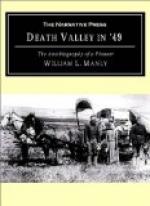On the second day the explorers began to return with very unfavorable reports, and many who found their progress thus blocked turned about and started to follow Hunt. Most of the wagons which remained had each one or more of their men out exploring and could not turn back until their return. Several of the Jayhawkers having once started on this route were very anxious to get through on it if a way could be found for them to do it, and therefore searched farther and with greater determination than the others. When they returned they reported they had found a way around the head of the canon and they believed it to be the right way. The map Williams had given them did not show this canon and they believed it to be correct, and that the real road led around at the place which they had found, and no further trouble would be met.
Acting on this report about twenty wagons, including the Jayhawkers, concluded to go ahead. “We can beat the other fellows a month,” said they, and so they hitched up and pulled out in a northerly direction, feeling in good spirits and hopeful of success.
They named this place Mt. Misery. While camped here a lone and seemingly friendless man died and was buried. None seem now to remember his name, but think he was from Kentucky. He was low with consumption and not strong enough to endure the hardships of the journey.
About the third night the Jayhawkers were overtaken by seven more wagons owned by A. Bennett and friends, J.B. Arcane and family, two men named Earhart and a son of one of them, and one or two other wagons.
The Jayhawker’s train was made up of men from many states, but seemed well united and was as complete as when they first started. The Author was with the party that came up in the rear, which had started later but traveled faster on account of having a road broken for them. He visited the leaders in camp when they were discussing the necessity of forming a new travelling compact to help and protect each other on the road. Those who had no families were objecting to being bound to those who had women and children with them. They argued that the road would be hard and difficult and those wagons with women and children would require more assistance than they would be able to render in return. They said they could go back and follow Hunt who was on a better road and they could proceed with more safely.
Among those with this train was Rev. J.W. Brier, his wife and three children. He objected to being turned back and said he did not want to be assisted, but would go with them and do his part and take care of himself. The Author listened to the various speeches without speaking and became satisfied that it would end in every one looking out for himself in case of hard times. He went over to their camp again the next night and wished to ask them why they were steering so nearly due north. He said to them that they were going toward Salt Lake rather than




